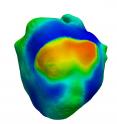Scientists use 'virtual heart' to model heart failure
A team of researchers have created a detailed computational model of the electrophysiology of congestive heart failure, a leading cause of death. This "virtual heart" could help medical researchers study new drug therapies - according to the study published in PLOS Computational Biology. Researchers from the University of California created a model that can simulate subtle changes from the cellular and tissue levels of the heart, up to the whole heart itself, then show the results of the associated electrocardiogram (ECG), a common tool that helps doctors diagnose heart abnormalities.
At the cellular and tissue levels, the model can show what happens to the heart when the levels and flow of calcium, potassium and sodium ions are changed. It also can take into account the speed at which a cell's ion channels, which take in those ions, work at.
At the organ level, the researchers created an anatomically detailed model of the heart, which then shows the big picture of what happens when various critical chemicals and electrophysiologic components of a healthy working heart are tweaked.
Additionally, during their study, the team found that ventricular fibrillation, where the waves of excitation that pump blood out of the heart become fragmented and discoordinated, can be caused by a heart failure-related slowdown in cellular processes at the top (basal) region of heart. The researchers also used their model to plan a new drug strategy against this heart failure form of fibrillation.
Source: PLOS
Articles on the same topic
- New pathway to treat heart failureMon, 27 Jun 2016, 19:43:40 UTC
- Eliminating blood test may increase availability of donor heartsFri, 24 Jun 2016, 20:23:13 UTC
- UTSW study finds new enzyme with structure that could explain how heart can beat optimallyFri, 24 Jun 2016, 20:23:03 UTC
